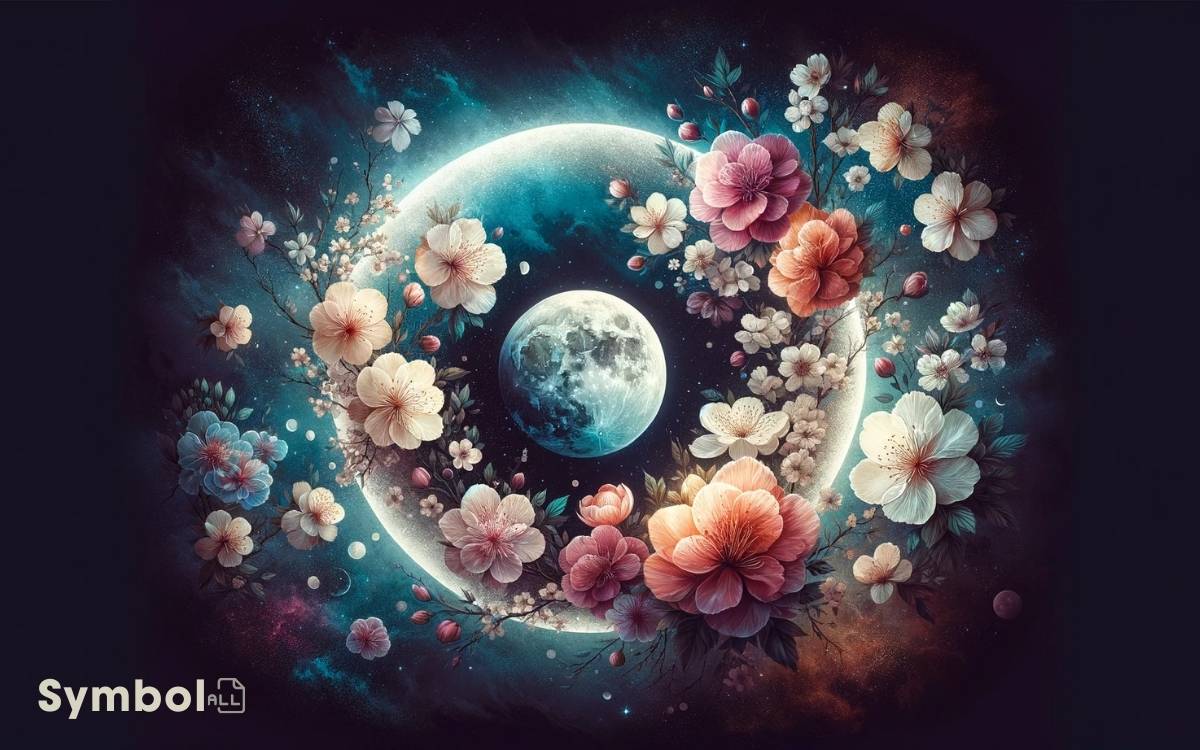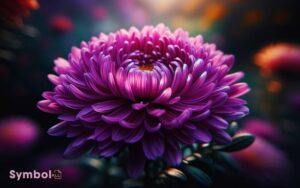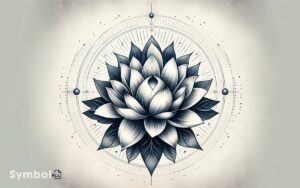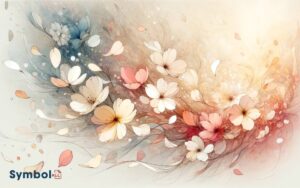What Does the Flower Moon Symbolize? Renewal, Fertility!
You’re exploring the rich tapestry of the Flower Moon, a symbol deeply rooted in Indigenous North American traditions. It’s more than a phase of the moon; it’s a celebration of renewal, fertility, and the undeniable beauty that blankets the earth.
This phase signifies a time for planting, reflecting the intimate bond between human activity and natural cycles. Cultures worldwide have looked to the Flower Moon to guide agricultural practices, honoring the earth’s bounty through rituals and festivals.
It’s a time for shedding the old and embracing new beginnings, promising prosperity and abundance. As you further engage with its stories and traditions, you’ll uncover layers of meaning that resonate across time and geography.

Key Takeaways
Origins of the Name
The name ‘Flower Moon‘ finds its roots in the linguistic and cultural practices of Indigenous North American tribes, marking the period when spring flowers are in abundant bloom.
This nomenclature, deeply embedded in the natural world’s rhythms, serves as a demonstration to these communities’ profound connection to the environment.
You’ll find that their calendrical systems, unlike the Gregorian calendar, aren’t arbitrary but intimately tied to ecological cycles. Each full moon carries a name that reflects significant seasonal changes, activities, or events.
The Flower Moon, thus, isn’t just a term; it’s a cultural marker that encapsulates the relationship between people and the planet. It reflects an understanding that time isn’t merely passing but is interwoven with the living tapestry of Earth’s cycles.
Symbol of Renewal
Building on the understanding of the Flower Moon’s origins, it’s clear how it also symbolizes a period of renewal, reflecting the regenerative processes of the earth that resonate deeply with human experiences.
This period of rejuvenation is characterized by:
- The Awakening of Flora: As flowers bloom, they signify the earth’s awakening from its wintry slumber, embodying the cycle of life’s rebirth and renewal.
- Purification of the Self: It’s a time when individuals are encouraged to shed the old and embrace new beginnings, mirroring nature’s process of renewal.
- Reconnection with Nature: The Flower Moon fosters a deeper bond between humans and the natural world, urging a harmonious coexistence and a mutual rejuvenation.
This cyclical pattern of renewal under the Flower Moon offers profound insights into the interconnectedness of life, emphasizing the natural world’s influence on human cultural and spiritual practices.
Celebration of Fertility
Delving into the Flower Moon’s celebration of fertility, it’s evident that this phase marks a pivotal moment for acknowledging and venerating the procreative powers of nature.
This time is deeply rooted in the fertility of the earth, where the burgeoning growth and blossoming of flora symbolize the potential for new life and abundance.
Cultures around the globe have recognized this period as a time to celebrate and invoke the fertility of the land, animals, and people.
| Aspect | Significance | Cultural Practices |
|---|---|---|
| Blossoming Flora | Symbol of potential and growth | Planting rituals |
| Earth’s Fertility | Foundation for abundance | Fertility dances and feasts |
| Renewal of Life | Cycle of birth, death, rebirth | Ceremonial offerings |
This season’s profound connection to fertility is not only a reflection of the natural world but also a metaphor for human creativity and productivity, urging you to reflect on the generative aspects of your own life.
Reflection of Beauty
In exploring the Flower Moon, one can’t overlook its embodiment of beauty, serving as a mirror to the aesthetic splendor inherent in nature’s cycles.
This lunar phase reflects more than just the physical blooming of flora; it’s a profound symbol woven into the fabric of various cultures, each interpreting its beauty in unique, significant ways.
To understand this reflection of beauty, consider the following aspects:
- Cultural Significance: Different societies view the Flower Moon as a representation of life’s ephemeral beauty, encouraging appreciation and mindfulness.
- Artistic Inspiration: Artists and poets often draw upon the imagery of the Flower Moon, using its transient beauty as a muse for creations that explore themes of growth, renewal, and the cyclical nature of life.
- Personal Reflection: For many, the Flower Moon is a time to reflect on personal growth and the beauty of change within their own lives.
Through these lenses, the Flower Moon’s beauty transcends mere aesthetics, embodying deeper meanings and reflections on existence itself.
Connection to Agriculture
The Flower Moon‘s influence extends deeply into agriculture, shaping planting cycles and harvest rituals across various cultures.
You’ll find that communities historically look to the Flower Moon as a sign that frost has passed, indicating it’s time to plant crops.
This lunar phase embodies a period of renewal and fertility, deeply entwined with the natural rhythms of the Earth.
As you explore its significance, you’ll uncover that its appearance is keenly observed by farmers and gardeners alike, serving as a guide for the best time to sow seeds.
This moon phase doesn’t just symbolize growth in a literal sense but also marks a period of preparation, nurturing, and anticipation for the bounty that the coming months will bring, highlighting its pivotal role in the agricultural calendar.
Indigenous Traditions
You’ll find that Indigenous cultures have intricately woven the Flower Moon into their lunar calendars, underscoring its significance in timing rituals and celebrations.
These practices aren’t just markers of time; they’re imbued with rich symbolic meanings that reflect a deep understanding of the natural world.
Through this lens, you can appreciate how these traditions serve both as a guide for seasonal activities and as a repository of cultural wisdom.
Lunar Calendar Integration
Many Indigenous cultures have intricately woven the phases of the moon into their calendars, marking time through celestial events like the Flower Moon.
This integration serves multiple purposes:
- Agricultural Planning: By observing the Flower Moon, communities can predict the best times for planting and harvesting, aligning agricultural practices with natural cycles.
- Social Organization: Moon phases dictate the timing of gatherings, hunts, and ceremonies, structuring societal activities around a lunar calendar.
- Cultural Preservation: These lunar calendars are a repository of ancestral wisdom, connecting current generations with their heritage and the natural world.
This approach to timekeeping emphasizes a deep connection with the environment, reflecting an understanding that human activities are best harmonized with the rhythmic cycles of nature.
Rituals and Celebrations
Indigenous communities across the globe celebrate the Flower Moon with rituals that embody their deep spiritual connection to the lunar cycle and the Earth’s renewal.
These ceremonies aren’t mere acknowledgments but profound expressions of gratitude and respect for the natural world’s cyclicality.
You’ll find that these rituals often involve communal gatherings, where storytelling, dancing, and the sharing of traditional foods play a pivotal role. They serve as a living bridge between past and present, teaching younger generations the importance of nature’s rhythms.
Each ritual, unique to its community, weaves a rich tapestry of cultural identity, spirituality, and environmental stewardship. Through these celebrations, indigenous peoples not only honor the Flower Moon but also reinforce their unwavering bond with the earth and its cycles.
Symbolic Meanings Assigned
In grasping the Flower Moon, it’s important to explore the intricate web of symbolic meanings that various indigenous traditions have woven around this celestial event.
You’ll find that:
- Renewal: Many indigenous communities see the Flower Moon as a symbol of renewal and rebirth. It signifies the earth’s reawakening after the long winter, with flora blooming and fauna emerging from hibernation.
- Abundance: This moon phase often symbolizes the promise of abundance. It’s a time when prayers and rituals are performed, invoking blessings for bountiful harvests and prosperity.
- Shift: For some tribes, the Flower Moon represents a critical shift period, marking a time to prepare for the upcoming changes in season, lifestyle, and community activities.
This synthesis of meanings underscores the Flower Moon’s role as a pivotal point in the indigenous cultural and spiritual calendar, offering deep insights into their connection with nature’s cycles.
Influence on Gardening
As you explore the Flower Moon’s impact on gardening, you’ll uncover how planting by lunar phases isn’t just folklore but a practice steeped in observation and tradition.
You’ll see how moonlight influences plant growth, offering insights that challenge conventional horticultural methods.
Planting by Lunar Phases
Adopting lunar phases in gardening greatly influences plant growth, as traditional practices have shown. This method, deeply rooted in ethnographic traditions, suggests that the gravitational pull of the moon affects moisture in the soil, thereby affecting plant growth.
Here’s how it works:
- New Moon to First Quarter: This phase is ideal for planting above-ground crops with external seeds, as the increasing moonlight and gravitational pull encourage seed germination and growth.
- First Quarter to Full Moon: During this period, the strong gravitational pull and increased moonlight are beneficial for leaf growth, making it perfect for planting crops that mature above ground.
- Full Moon to Last Quarter: This phase is suited for planting root crops, as the decreasing moonlight and gravitational pull focus energy below the soil surface.
Understanding these phases allows you to work with nature, optimizing your gardening efforts by aligning with lunar rhythms.
Moonlight and Plant Growth
Moonlight plays a pivotal role in the natural cycle of plant growth, influencing various gardening practices rooted in ethnographic traditions.
You’ll find that cultures across the world have observed the subtle yet significant effects of moonlight on plants, integrating this evidence into their agricultural rituals.
This isn’t mere folklore; scientific studies hint at moonlight’s influence on plant behavior, such as leaf movement and growth patterns.
While direct moonlight isn’t as intense as sunlight, its presence during specific lunar phases is believed to affect the absorption of nutrients and water, making certain nights more auspicious for gardening activities.
This knowledge, passed down through generations, serves not only as a demonstration of human connection with nature but also guides modern gardeners seeking to align with these natural rhythms for more fruitful outcomes.
Harvest Timing Insights
Understanding the lunar cycle’s influence on harvest timing can greatly enhance your gardening outcomes, drawing on ancient wisdom that aligns agricultural practices with the moon’s phases.
Cultures across the globe have recognized the moon’s significant impact on plant growth and harvest success.
Here’s how the lunar cycle, especially during the Flower Moon, influences gardening:
- Seed Planting: Traditionally, seeds are sown shortly after the new moon when increasing light promotes leaf growth.
- Transplanting: The waxing moon phase, leading up to the full moon, is considered ideal for transplanting, encouraging root development.
- Harvesting: Harvesting is often done as the moon wanes, believed to increase the shelf-life and flavor of produce.
This cyclical approach integrates the moon’s natural rhythm into gardening, potentially optimizing plant vitality and yield.
Time of Abundance
In many cultures, the Flower Moon symbolizes a period of prosperity and fertility, reflecting nature’s generous bounty during this time.
You’ll notice the landscapes transform, teeming with life and color. This lunar phase is not just a celestial event but a marker of seasonal change, indicating it’s time for abundance.
| Culture | Interpretation of Abundance |
|---|---|
| Native American | Renewal of Earth’s resources |
| Eastern | Growth and prosperity in farming |
| Western | Time for planting and hopes for a fruitful harvest |
This period encourages societies to connect with the earth, acknowledging the cycle that sustains human life.
It’s a reminder of the delicate balance between taking from and giving back to nature. The Flower Moon’s message is clear: cherish and nurture the abundance that surrounds you.
Spiritual Significance
You’ll find that the Flower Moon‘s spiritual significance is deeply rooted in its connection to the lunar cycle, symbolizing a time of renewal and purity. During this phase, many cultures see it as an opportunity to set intentions, release negativity, and embrace personal growth, aligning with the transformative energy of the moon. The Flower Moon also evokes themes of interconnectedness, reminiscent of the Egyptian Flower of Life meaning, which symbolizes harmony, creation, and the infinite cycles of existence. This sacred geometry intertwines beautifully with the moon’s essence, inviting reflection on the intricate patterns within our lives and the universe.
This period reflects Native American beliefs, where the moon’s phases are integral to understanding the natural world and our place within it.
Observing this celestial event, you’re invited to contemplate its role in marking shifts and fostering spiritual growth.
Lunar Cycle Connection
The Flower Moon’s phase in the lunar cycle holds deep spiritual significance, reflecting a time of growth, blossoming, and renewal within various cultures and traditions.
This connection isn’t arbitrary but deeply ingrained in the collective human consciousness, manifesting in several key ways:
- Cyclical Awareness: It reminds us of the cyclical nature of life, encouraging reflection on personal growth and the shedding of old habits.
- Ritual Significance: Many communities hold rituals during the Flower Moon to honor the fertility of the earth, symbolizing a direct link between the lunar cycle and the natural world’s rhythms.
- Symbolic Reflection: This phase serves as a mirror, reflecting the internal journey of individuals, paralleling the external bloom with inner spiritual awakening.
Understanding this connection offers a richer appreciation of the Flower Moon’s role in spiritual practices, highlighting its significance beyond just a celestial event.
Renewal and Purity
Amidst the blooming of the Flower Moon, cultures worldwide celebrate its spiritual significance, marking a period of renewal and purity that echoes the natural world’s rejuvenation.
This moon phase isn’t just a signal of the Earth’s awakening from its wintry slumber but also embodies a deeper, spiritual cleansing and rebirth among various communities.
You’ll find that this time is ripe for casting off the old and embracing the new, mirroring the fresh blossoms that define the season.
It’s a moment when the boundary between the physical and spiritual dimensions thins, offering a unique opportunity for introspection and purification.
Through rituals and celebrations, people align themselves with the cyclical nature of life, fostering a sense of connection and renewal that transcends the mere observation of a celestial event.
Native American Beliefs
Within Native American cultures, the Flower Moon holds profound spiritual significance, serving as a symbol of rebirth and connection to ancestral lands. This period is deeply interwoven with:
- Rituals and Ceremonies: Many tribes conduct ceremonies that align with the Flower Moon to honor the earth’s renewal and to pray for good harvests.
- Storytelling and Oral Traditions: Elders share stories under the Flower Moon that pass down wisdom and connect the present generation to their ancestors, weaving a tapestry of shared history and values.
- Spiritual Renewal: This moon phase is a time for individual and communal reflection, a moment to reconnect with the spiritual aspects of life, and an opportunity to cleanse one’s soul in preparation for the seasons ahead.
Analyzing these practices reveals how the Flower Moon embodies a multifaceted symbol of life, continuity, and spiritual sustenance within Native American cultures, fostering a deep-rooted respect for nature’s cycles.
Astrological Implications
Delving into the astrological implications, you’ll find that the Flower Moon ushers in a period of growth and flourishing, both metaphorically and literally, in various cultural contexts.
This phase of the moon invites you to reflect on personal development and the blooming of ideas and projects. It’s a prime time for setting intentions that align with natural cycles, fostering a deeper connection with the rhythms of the universe.
| Aspect | Influence |
|---|---|
| Personal Growth | Enhanced creativity and vision |
| Relationship Dynamics | Strengthened connections and understanding |
| Professional Life | Opportunities for advancement and innovation |
| Spiritual Path | Heightened intuition and clarity |
This celestial event symbolizes a bridge between the physical and the metaphysical, urging you to embrace change and the potential for renewal.
Cultural Celebrations Worldwide
Around the globe, diverse cultures celebrate the Flower Moon with unique traditions that reflect their historical and spiritual connections to this celestial event.
As you explore these celebrations, you’ll find:
- Native American Tribes: Many tribes mark the Flower Moon as a time of fertility and renewal, with ceremonies that often involve dancing, storytelling, and the planting of crops, symbolizing a deep-rooted connection to the earth and its cycles.
- Eastern Asia: In countries like Japan and Korea, the Flower Moon period coincides with festivals celebrating flowers and nature’s beauty, emphasizing harmony and the transient nature of life.
- Europe: Ancient pagan traditions, now interwoven with modern celebrations, observe the Flower Moon as a period to honor nature’s abundance, often through rituals that include flower garlands and bonfires, reflecting a reverence for the earth’s renewal.
Each of these celebrations offers a unique lens through which to understand the cultural significance of the Flower Moon, highlighting the universal human connection to the natural world.
Conclusion
In dissecting the myriad layers behind the Flower Moon‘s symbolism, you’ve journeyed through a tapestry of human connection to nature.
This moon doesn’t just mark a phase in celestial movements; it’s a reflection of humanity’s intertwined relationship with the cycles of life.
From its roots in agriculture to its spiritual connotations, the Flower Moon encapsulates a period of blooming and abundance. It’s a reminder of the cyclical beauty of existence, celebrating the renewal that touches every corner of human culture.
Through this lens, the Flower Moon isn’t just observed; it’s deeply felt, echoing the eternal dance between earth and cosmos.






